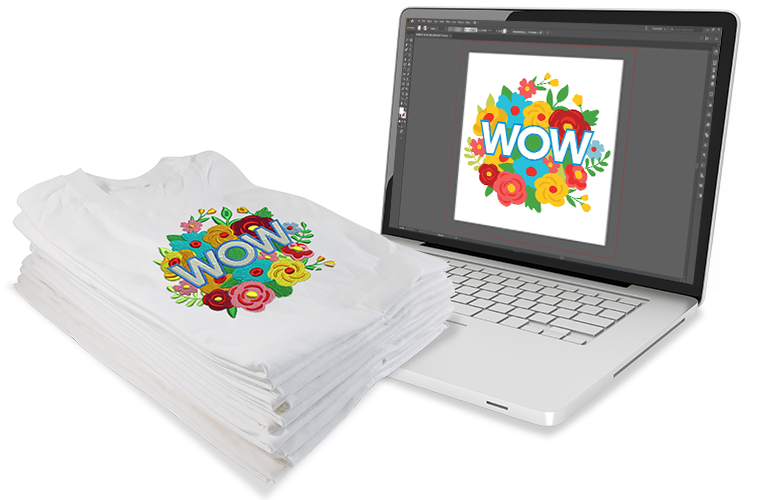Simplifying the Art of Needlework Digitizing: Step-by-Step Guide
As technology continues to advancement, the digitization procedure has actually become more available, allowing enthusiasts to bring their detailed styles to life with simplicity. In this overview, we will certainly untangle the complexities of embroidery digitizing, damaging down each step carefully to enhance the process and equip both beginners and skilled embroiderers alike.
Comprehending Needlework Digitizing Software Program
Embroidery digitizing software functions as a vital device for changing elaborate layouts right into digital styles suitable with embroidery equipments, assisting in specific stitching and customization. This specialized software program permits customers to import different image documents layouts, such as JPG or PNG, and transform them into needlework machine-readable styles like DST, EXP, or PES - Digitizing for Embroidery. By utilizing attributes like stitch editing, rug choices, and string shade option, digitizing software allows users to manage every facet of the style procedure
Additionally, advanced embroidery digitizing software uses tools for developing complicated layouts, changing stitch thickness, and including elaborate information. Customers can likewise preview the layout prior to sewing it out, making certain precision and decreasing errors. Additionally, numerous software application offer automated functions that aid streamline the digitizing procedure, conserving time and initiative.
Understanding the capabilities of embroidery digitizing software application is vital for accomplishing premium outcomes in needlework projects. By understanding this tool, embroidery enthusiasts and specialists can unleash their creative thinking and bring intricate layouts to life with accuracy and performance.

Choosing the Right Layout Data
After familiarizing yourself with the capacities of embroidery digitizing software, the next essential action in the process is choosing the best layout declare your project. Digitizing for Embroidery. When selecting a style apply for embroidery digitizing, it's crucial to think about the complexity of the layout, the dimension of the final item, and the sort of material you will certainly be functioning with
For elaborate layouts with great details, a high-resolution image or vector data is recommended to ensure that the embroidery machine can accurately duplicate the layout. Furthermore, the size of the end product plays a considerable duty in selecting the right design file. Larger designs may need greater resolution data to maintain clearness and sharpness.
Additionally, the kind of textile you will certainly be embroidering on affects the option of design documents. Various fabrics may need changes in the design documents to guarantee that the stitches are properly lined up and the layout looks like meant. By thoroughly picking the best style file based upon these variables, you can set on your own up for an effective embroidery digitizing procedure.
Digitizing Devices and Methods
Making use of specialized software program and accuracy methods, digitizing devices are crucial in changing complex designs right into embroidery-ready files. Embroidery digitizing software, such as Wilcom, Hatch, or Embrilliance, offers the essential platform to transform art work into stitch information. These programs use functions like stitch modifying, rug choices, and text devices to make sure the layout converts seamlessly onto fabric.
Among the crucial techniques in digitizing is creating a clear course for the embroidery machine to follow. This entails digitizing each component of the design with precision, identifying stitch kinds, thickness, and directions. By utilizing tools like digitizing news tablet computers or software-specific plugins, embroiderers can attain a high level of precision in their digitized designs.
In addition, understanding the art of rug sewing is essential for producing quality embroidery. Underlay sewing supports the textile and produces a structure for the style, making sure that the end product is both visually attractive and lasting. By recognizing these digitizing tools and techniques, embroiderers can elevate their craft and bring detailed layouts to life with accuracy and effectiveness.
Tailoring Stitch Types and Directions
Having developed a structure in digitizing tools and methods, a vital aspect in progressing needlework workmanship lies in customizing stitch types and directions with precision and objective. The selection of stitch kinds can considerably impact the total appearance and texture of the stitched design. Satin stitches, known for their smooth and glossy surface, work well for creating borders and text. On the other hand, fill stitches are optimal for covering bigger areas successfully. By purposefully integrating these stitch kinds, embroiderers can attain deepness and measurement in their styles.
Moreover, the direction of stitches plays an important role in boosting the visual charm of the final needlework. Diverse stitch directions can add structure, highlight certain elements, and produce aesthetic passion. For example, altering the angle of stitches can imitate movement or natural patterns like hair or plumes. By trying out different stitch angles and patterns, embroiderers can bring their styles to life with amazing detail and details. Understanding the art of tailoring stitch kinds and instructions empowers embroiderers to unleash their imagination and boost the top quality of their job.
Testing and Refining Your Digitized Design
To ensure the precision and high quality of your digitized style, comprehensive screening and refinement are vital steps in the embroidery digitizing procedure. When you have actually finished the digitization of your design, it is crucial to examine it before waging the actual needlework. Examining allows you to identify any kind of potential problems such as thread breaks, stitch thickness troubles, or style distortions that might impact the final result.

After screening, it is very important to improve your digitized layout based on the responses from the test sew-out. This might entail tweaking sew settings, changing densities, or making modifications to the general style to attain the desired outcome. By repeating through screening and improvement, you can adjust your digitized style to excellence prior to moving on with the real embroidery procedure.
Final Thought
Finally, understanding the art of embroidery digitizing requires a complete understanding of the software program, choosing the ideal design documents, utilizing digitizing tools and techniques, personalizing stitch Click This Link types and instructions, and screening and fine-tuning the digitized style. By following these actions, embroiderers can simplify the digitizing process and create high-quality stitched styles with accuracy and effectiveness.